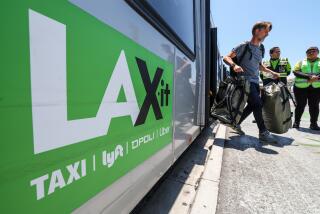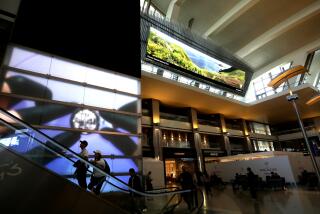Listening Posts to Double : Airport Panel Clears Way for Noise Monitors
The Los Angeles Board of Airport Commissioners moved Tuesday toward placing a more sophisticated noise-monitoring system at three of the city’s four airports, including Van Nuys Airport.
The commissioners voted unanimously to give the Department of Airports staff authority to negotiate the final arrangements for the system with Tracor Applied Sciences of Austin, Tex., and Wyle Laboratories of El Segundo.
Negotiations will continue over the price, but the system is expected to cost “in the neighborhood of $2 million,” said Robert M. Beard, the department’s noise-abatement officer. About 80% of the cost will be covered by grants from the Federal Aviation Administration for noise reduction, he said.
Because of the task of designing, installing and testing it, the system is not expected to be in operation until 1989, he said.
Sites to Double
The system will double the number of monitoring sites at three city-owned airports--Los Angeles International, Ontario and Van Nuys--and greatly increase the computer capacity of the system, the major element in the overhaul.
“The capacity of the current system is . . . less than many computers for kids’ games,” Beard said. “It’s at capacity. There’s no way to add anything to it.”
The computer will have about 10 times the capacity, enabling it to receive more data and process it in ways to meet stricter noise-control standards, he said.
The existing system, operated by the computer at LAX, has 24 monitoring sites--microphones atop phone poles and connected to the computer by phone line. A dozen are around LAX, eight at Ontario and four at Van Nuys.
The new system will probably have 26 sites around LAX, 15 at Ontario and 7 at Van Nuys, Beard said.
Noise recorded at the sites is now used to determine the Community Noise Equivalent Level--a statistic derived from averaged readings that is the basic measuring standard used in noise-control laws.
A major feature of the system at LAX and Ontario will be its ability to attribute a recorded noise to a specific aircraft, by correlating its tapes with flight-control tapes of radar and radio kept by the FAA control tower, he said.
Detecting the Source
The present system records noise but cannot trace it to specific aircraft.
The FAA agreed to share its tapes, however, only if the city agrees not to use the information to take legal action against pilots or airlines violating its requested noise-control procedures, Beard said. Only the FAA has authority over aircraft in flight.
However, he said, city authorities will be able to “identify which airplanes are doing what, and contact the airlines or pilots and ask for their cooperation,” as they do now when a violation of the requested procedures can be attributed to a specific plane.
There are no plans to include that capacity at Van Nuys, he said. But the additional monitoring equipment at Van Nuys will be used to improve administration of noise-control laws.
The system will also refine the ability to distinguish aircraft noise from other sounds, such as motorcycles or cars, by being programmed to recognize factors such as duration at a steady frequency and by comparing recordings from more than one site. “Motorcycles can be tough, and some Volkswagens sound just like aircraft,” Beard noted.
More to Read
Sign up for Essential California
The most important California stories and recommendations in your inbox every morning.
You may occasionally receive promotional content from the Los Angeles Times.










